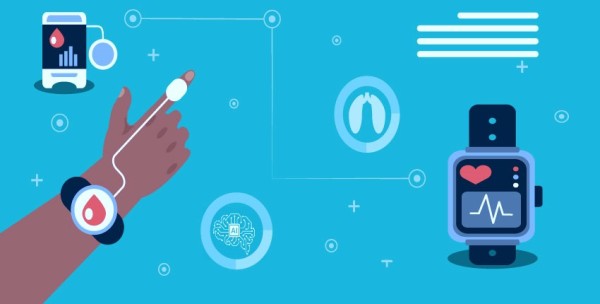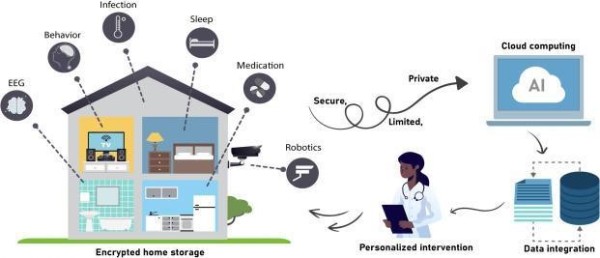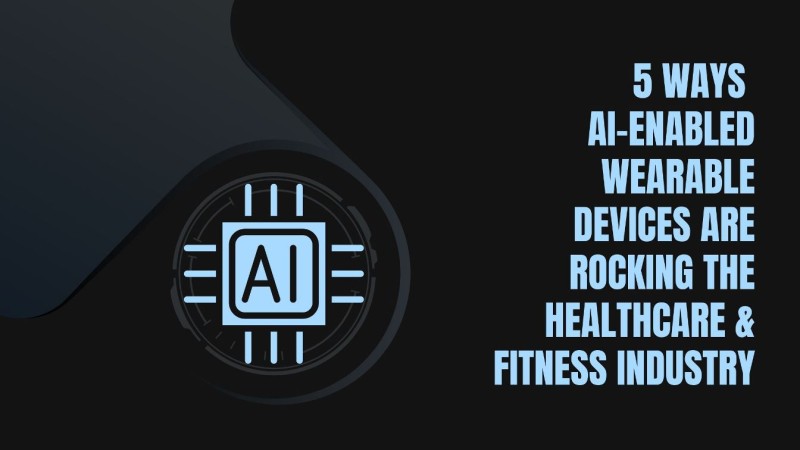“Intelligence is the ability to adapt to change,” said Stephan Hawking.
Everything around us is clearly evolving towards intelligence. AI & IoT has definitely transformed our lives in a lot of ways. AI pushes this envelope further by enabling devices to transform how we envision our health and wellbeing with useful insights.
For many decades, wearable technology has been a significant part of our daily lives and it has been an important digital transformation. The market for wearable artificial intelligence is anticipated to rise from USD 11.5 billion in 2018 to USD 42.4 billion by 2023, expanding at a CAGR of 29.75% and it is projected to reach $145 billion by 2030. MarketsandMarkets as a source
The Internet of Health Things (IoHT), where medical equipment and apps are linked to the healthcare IT system, has been driving the advancement of wearable devices in the healthcare business. The Internet of Things in medical devices uses machine-to-machine (M2M) communication and connectivity to a cloud platform to gather, store, and analyze the data produced by devices.
Larger companies like Apple, Xiaomi, Huawei, Fitbit, and others are developing wearable technology with AI capabilities as the market for wearables expands, pushing the technology's capabilities further and further.
AI in wearables aims to enhance user experience and functions to give users real-time insights, statistics, and guidance to make wise lifestyle decisions.
HEALTHCARE WEARABLES WITH AI
Wearables often collect, monitor, and engage with users' health data in the healthcare industry. It offers the user and doctor timely awareness of various health factors. - for instance, wearable sensors for real-time health monitoring, fitness wearables, senior care wearables, etc.
Wearables in the healthcare sector use AI to enhance life in various ways. Take the Google Brain initiative's study on AI-powered diabetic eye disease diagnosis as an example. In this system, deep learning-based mathematical algorithms enable neural networks to learn and carry out a specific task through repetition and self-correction.
Over 100 human-graded fundus images that depict different degrees of retinal bleeding brought on by elevated blood sugar levels were used to train this mathematical system. The algorithm assigns each image a severity grade, and then a comparison is made with a previously established grade from the training set. Then, the parameters are slightly changed to reduce the inaccuracy of that image. The algorithm learns how to correctly calculate the diabetic retinopathy severity from the pixel intensities of the image for each image in the training set by repeatedly performing this process for each image in the training set.

THE CHANGE IS PRESENTLY TAKING PLACE
It is not a far-fetched idea to use wearable technology with AI capabilities to offer telemedicine services. A similar device is already available and was given FDA approval in April of this year. NHS hospitals in Dartford and Gravesham have partnered with Current (previously Snap40) for a pilot project to monitor patients' vital signs remotely and use artificial intelligence to analyze those readings.
Patients are given a wi-fi enabled armband that records their vital signs when they are ready to be discharged. They also get a tablet with a chatbot, which can be used to communicate with the doctors remotely via text and video while reminding them to take their medications and providing them with health-related information.
These devices can detect warning signs and alert patients and doctors because artificial intelligence algorithms continuously analyze real-time health data.
ADVANTAGES OF IOT DEVICES ENABLED BY AI
Ongoing advances in hardware and software back the development of wearable technology powered by AI algorithms. The days of large devices are over. Wearable technology is available in various sizes and shapes, and patients can wear them comfortably, increasing compliance. The development of artificial intelligence in recent years is also encouraging the use of these medical gadgets.
Here are some advantages telemedicine's use of AI and IoT can provide for healthcare delivery.
-
PERSONALIZED HEALTH CARE
Now we can analyze a person’s health data in real time using artificial intelligence by mounting advanced biosensors on wearable devices. Healthcare professionals might adopt a data-driven strategy thanks to the patient information gathered through wearable technology. As a result, doctors can make informed decisions and create personalized health plans for each patient.
While medical gadgets give patients access to their health information, professional medical involvement is still required if patient engagement is to be increased. Medical professionals must interpret and explain patient data, which is where telemedicine comes into play.
The AI algorithms can create personalized and unique action plans using the data gathered by the IoMT sensors. The treating doctor can then remotely oversee the implementation of the plans, track the development, and make adjustments as needed, leading to improved health results. Similar techniques are already being used in some devices, such as implantable insulin pumps.
-
EARLY DETECTION AND PROMPT ACTION
AI programs are designed to make decisions, often using deep learning and computer-guided programs that analyze and process raw data into clinical decision making for effective treatment. AI-based analysis of radiological and histological data has already produced encouraging results. Utilizing wearable AI-powered gadgets to assess patients and generate risk profiles can lead to prompt telemedicine treatments and enhance overall results.
The establishment of particular touchpoints and prompt interventions are also made possible by identifying "at-risk" patients, which eases the strain on hospitals, lowers hospital admission and readmission rates, and lowers the overall cost of healthcare.
When deciding when to consult a doctor, the patient and his caretakers might not be the greatest judges. AI has revolutionized the entire health care system through innovative digital diagnostics with greater precision and accuracy. AI is capable of detecting cancer at an early stage with accurate diagnosis and improved survival outcomes.
-
REMOTE PATIENT OBSERVATION
The wearable devices monitor the vitals minute-by-minute, in contrast to the conventional hospital setup, where nurses and doctors check on the patient frequently. As a result, any irregularity that happens may be found immediately, which enables prompt notification of the medical community and prompt healthcare service.
The way we gather and evaluate patient data has changed thanks to AI-powered wearable technologies. These gadgets are widely accessible and used, simplifying post-hospitalization monitoring. Real-time patient data is accessible to healthcare providers. They can gain critical insights into trends and patterns thanks to AI-processed data, which improves the efficiency of healthcare services.

A resource-effective tactic is to use telemedicine to conduct follow-up visits and treat patients remotely. As a result, healthcare professionals can provide for many patients while lowering the price of healthcare.
By eliminating the need for patients to schedule trips to and from the hospital for follow-up appointments, virtual healthcare delivery also helps patients save time and money. It also lowers the likelihood of readmissions to the hospital and, most significantly, unnecessary fatalities.
-
BOTH DISEASE IDENTIFICATION AND THERAPY
Researchers found that applying artificial intelligence to the right combination of data retrieved from wearable technology may detect whether your health is failing. The study found that the data from wearable sensors and artificial intelligence that assesses changes in aerobic responses could one day predict whether a person is experiencing the onset of a respiratory or cardiovascular disease.
The data collected from different wearable sensors like body temperature, glucose sensors, heartbeat sensors, and chest are transmitted through IoT devices to the integrated cloud database. To select the most useful features from the captured data, the ML is used, and the sensor signal is analyzed using ML for diagnosis of patient data.
Wearable technology and AI can also make the therapy phase more efficient. Patients and healthcare professionals must periodically interact, especially during cancer treatment. The patients spend much time away from the clinical setting, where the side effects must be monitored, even when intensive chemotherapy is being administered.
-
PAY ATTENTION TO DATA SECURITY
Although there are many uses for collecting and analyzing patient data, healthcare data is, by its very nature, sensitive. It is also governed by several laws and regulations, including the GDPR, HITECH, and HIPAA, to name a few. Therefore, you must develop sufficient safeguards for the security of the patient data gathered and kept before implementing any technology that includes collecting patient data.
You must ensure that the cloud hosting provider complies with the data security standards if you host health data in the cloud. Special considerations and additional security measures like data encryption and two-factor authentication must be established to ensure that the patient data gathered and stored comply with regulatory standards.
BOTTOM LINE
This multi-disciplinary research is a great example of how artificial intelligence can be a potential game-changer for healthcare by turning data into predictive knowledge to help healthcare professionals better understand an individual's health.
The healthcare sector could benefit long-term from integrating wearable technologies with AI. However, focusing on the sensitivity of patient data and maintaining compliance with security and regulatory standards are essential for successfully implementing the same.
The technical developments currently occurring in the healthcare industry are only the beginning. Technology can have a significant impact and use in many different contexts.
With AI and machine learning, companies become more efficient through process automation, which reduces costs and frees up time and resources for other priorities.
Algo Coding Experts provide customized AI and ML solutions that can revolutionize your business and give you a competitive edge in your market.
Also Read: Innovation in Construction: Green Technology


